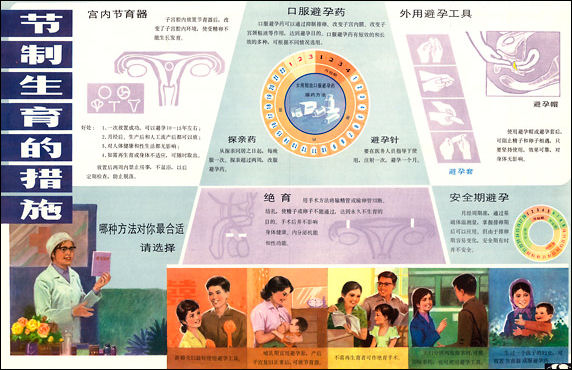BIRTH CONTROL IN CHINA

birth control poster Some 83 percent of all women in China use contraception (compared to 29 percent in Cameroon and 81 percent in the United Kingdom). In ancient China, women were told that consuming mercury heated in oil would prevent them from having babies. It may have worked because mercury can kill a fetus — and a mother too.
In 2020, the China Family Planning Association, Tsinghua University’s Research Center for Public Health, and China Youth Network conducted a sex survey involved 54,580 students from 1,764 universities nationwide. Zhang Wanqing wrote in Sixth Tone: More than half of the surveyed students said they used contraception during sex every time, while 3 percent never used protection. Nearly one-quarter of respondents did not believe contraception was necessary, and 16 percent of female respondents said their partner typically decided whether they used contraception. According to the survey, 5 percent of university students had experienced unintended pregnancy — a decline from the 11 percent reported in the last survey, published in 2016. Of these people, 94 percent sought an abortion, 17 percent more than once. A majority of those who sought abortions opted for surgical procedures, while less than 20 percent went with medical abortions. [Source: Zhang Wanqing, Sixth Tone, May 15, 2020]
The Shengyubiao was a conception calendar — based on a woman’s age in lunar months and the month of conception — used by women to give birth to a child of a specific sex. The whole concept had long been dismissed as a superstition and an old wives tale but in the early 2000s, Italian researchers found that conception dates can in fact affect the sex of a child.
Puberty tends to start earlier as countries develop and children's diets improve; in China, the starting age has fallen from about 14.5 in the 1970s to 12 ½ years old. Meanwhile, the average marriage age has edged up, from 20 in the 1970s to 22 now, extending the time that many young people can be sexually active but unmarried. Li Shuzhuo, a demographer at the Institute for Population and Development Studies in Xian, says it is clear that there has been a big shift from post-marriage to pre-marriage abortions. [Source: Alexa Olesen Associated Press, January 10, 2011]
Contraceptive prevalence rate: 84.5 percent (2017). This figure is the percent of women of reproductive age (15-49) who are married or in union and are using, or whose sexual partner is using, a method of contraception. [Source: CIA World Factbook, 2021]
Contraceptive use (any method, women ages 15-49): 85 percent (2017, compared to 12 percent in Sudan and 84 percent in the United Kingdom) [Source: World Bank ]
Websites and Sources: Illegal Births, Legal Abortion ncbi.nlm.nih.gov ; China.org article China.orh ; Family Planning info asianinfo.org ;
See Separate Articles: POPULATION OF CHINA factsanddetails.com ; POPULATION GROWTH IN CHINA factsanddetails.com ; CENSUSES IN CHINA factsanddetails.com ; DEMOGRAPHIC ISSUES IN CHINA: factsanddetails.com ; SURROGATE BIRTHS, FROZEN EGGS AND IN-VITRO TREATMENTS AMONG CHINESE factsanddetails.com ; ABORTIONS IN CHINA factsanddetails.com ; SEX RATIO, PREFERENCE FOR BOYS AND MISSING GIRLS IN CHINA factsanddetails.com ; BRIDE SHORTAGE, UNMARRIED MEN AND FOREIGN WOMEN FOR SALE IN CHINA factsanddetails.com ; ONE-CHILD POLICY factsanddetails.com ; SERIOUS PROBLEMS WITH THE ONE-CHILD POLICY: factsanddetails.com ; END OF THE ONE-CHILD POLICY IN CHINA factsanddetails.com
RECOMMENDED BOOKS: “Reproductive Realities in Modern China” by Sarah Mellors Rodriguez Amazon.com; “Birth Control in China 1949-2000: Population Policy and Demographic Development” by Thomas Scharping Amazon.com; “China's Longest Campaign: Birth Planning in the People's Republic, 1949–2005" by Tyrene White Amazon.com; “A Man-Made Disaster: A Log Of The Birth Control Campaign In 1975 In China” by Ruo Lan Amazon.com; “Premarital Abortion in China” by Ruby Lai Amazon.com
Birth Control Laws and Policy in China
 Birth control is established by the Chinese Constitution as a fundamental policy of the nation. Citizens bear the statutory obligation to practice birth control under the law. The PRC Law on the Population and Family Planning “advocates” one couple to have only one child, with exceptions provided by provincial-level population control regulations when a couple “may apply” to have two children (most likely to couples in rural areas whose first child is female). [Source: Library of Congress Law Library, Legal Legal Reports, 2007]
Birth control is established by the Chinese Constitution as a fundamental policy of the nation. Citizens bear the statutory obligation to practice birth control under the law. The PRC Law on the Population and Family Planning “advocates” one couple to have only one child, with exceptions provided by provincial-level population control regulations when a couple “may apply” to have two children (most likely to couples in rural areas whose first child is female). [Source: Library of Congress Law Library, Legal Legal Reports, 2007]
The government, however, implements the “advocated” policy strongly, which is widely criticized to be violating international human rights standards set up in the international children’s right documents mentioned in above part II. The Congressional-Executive Commission on China (CECC) detailed the coerced compliance with the policy performed by the officials to be “through a system marked by pervasive propaganda, mandatory monitoring of women’s reproductive cycles, mandatory contraception, mandatory birth permits, coercive fines for failure to comply, and in some cases, forced sterilization and abortion.”
In its 2007 Annual Report, the CECC concludes that in 2007:China continues to implement population planning policies that violate international human rights standards. These policies impose government control over women’s reproductive lives, result in punitive actions against citizens not in compliance with the population planning policies, and engender additional abuses by officials who implement the policies at local levels. In 2007, the Party and government leadership reaffirmed its commitment to its population planning policies, and continues to implement such actions as charging large “social compensation fees” to families that bear children “out of plan.”
Birth Control Methods in China
Types of birth control used (2015); female sterilization: 28.2 percent; male sterilization: 4.4 percent; pill: 1.2 percent; injectible: 0 percent; implant: 0.3 IUD: 39.9 percent; male condom: 8.3 percent; vaginal barrier: 0.2 percent; early withdrawal: 0.5 percent; rhythm method: 0.5 percent; traditional: 0 percent total: 83.4 percent [Source: Trends in Contraceptive Use Worldwide 2015 - the United Nations un.org/en/development/desa/population/publications ]
Contraceptive methods (2001): 1) IUDs (intrauterine devices, 46 percent); 2) female sterilization (38 percent); 3) male sterilization (8 percent); 4) condoms (8 percent); 5) pills and injections (2 percent); 6) other (1 percent). In the 1980s, contraceptive methods utilized included: diaphragm (50.8 percent), tubal ligation (21.8 percent), pills (7.5 percent), vasectomy (1.2 percent), others (12.3 percent), and none (6.4 percent). Birth control measures used by urban couples included: diaphragms (42.8 percent), tubal ligation (9.4 percent), other mechanical means (18.3 percent), pills (5.9 percent), vasectomy (2.3 percent), other methods (e.g., “safe periods,” coitus interruptus, unknown) (15.5 percent), and none (5.8 percent). [Source: “1989-1990 Survey of Sexual Behavior in Modern China: A Report of the Nationwide “Sex Civilization” Survey on 20,000 Subjects in China: by M.P. Lau’, Continuum (New York) in 1997, Transcultural Psychiatric Research Review (1995, volume 32, pp. 137-156), Encyclopedia of Sexuality ++]
Types of birth control used (1994): female sterilization: 35.6 percent; male sterilization: 10.1 percent; pill: 3.1 percent; injectible: 0.0 percent; implant: 0 percent; IUD: 30.3 percent; male condom: 4.7 percent; vaginal barrier: 0 percent; early withdrawal: 0.2 percent; rhythm method: 0.6 percent; traditional; 0.1 percent total: 83.8 percent [Source: Trends in Contraceptive Use Worldwide 2015 - the United Nations un.org/en/development/desa/population/publications ]
Top method of contraception: IUD (intrauterine device, also known as intrauterine contraceptive) is small device or coil, often T-shaped birth control device. It is inserted into the uterus to prevent pregnancy and is valued as a long-acting reversible birth control. [Source: Birth Control Around the World onlinedoctor.superdrug.com ]
Abortion is widely used among single women. Evan Osnos wrote in The New Yorker: Today, family planning is promoted by a vast system that dispenses contraceptives and keeps track of births, but it mainly focusses on married couples. Partly because contraceptives were not as actively promoted to unmarried people, hospitals had described an uptick in voluntary abortions by single women in recent years, and services were advertised as ‘safe & Easy A+.” [Source: Evan Osnos, The New Yorker, June 15, 2012]
Family Planning, Late Marriage and Contraception in China
Alexa Olesen of Associated Press wrote: “The mainland's family planning network is enormous and efficient, a virtual population control army that promotes contraception and meticulously logs births, abortions and sterilizations - but it focuses mainly on married couples.” The manager at one family-planning clinic told AP that she has wanted to tell young people how to use pills and condoms properly when she lectures at high schools and colleges, but administrators often force her to stick to dating etiquette and menstruation. "They don't want me to mention contraception," she says. "They are afraid I will corrupt the students." [Source: Alexa Olesen Associated Press, January 10, 2011]
According to the Encyclopedia of Sexuality, published in the early 1990s, all kinds of contraceptive measures, from condom to pill, are available and used in China’s practice of family planning. In 1989, it is estimated that more than 70 percent of couples of child-bearing age are using contraceptives, over 8.8 million males have undergone sterilization injections or operations, including a new reversible sterility operation. For females, the most popular birth control method is the intrauterine devices (IUDs). Used by 60 million women in the country, the IUD accounts for 41 percent of the total contraceptive measures; female sterilization operations constitute 36 percent. Research on a variety of oral contraceptives in the country has also reached advanced levels and these are available to the public. Breakthroughs have recently been reported in the development of medicines for terminating early pregnancy. In 1992, a survey showed that 83.4 percent of married couples have adopted contraceptive practices, 40 percent of them are using IUDs, 39 percent female sterilization, 12 percent male sterilization, 5 percent oral pills, and 4 percent condoms. Infertility due to sexual dysfunctions was common (e.g., more than 25 percent of about 40,000 family planning counseling cases seen in 1984 to 1989), but most were said to be somewhat amenable to medical or herbal therapy. [Source: Zhonghua Renmin Gonghe Guo, Fang-fu Ruan, M.D., Ph.D., and M.P. Lau, M.D. Encyclopedia of Sexuality =]
“Until the recent past, the Chinese people were controlled on the local level by danwei - the unit or institution one belongs to. In order to marry, a couple must have a legal registration and a permit letter from his/her danwei. Usually one’s danwei leader checks one’s age - while the minimum legal marriageable age is 22 for males and 20 for females, “later marriage age” policy stipulates an age of 27 to 28 for males and 24 to 25 for females in order to help in the control of population. A 1991 survey in Nanjing, the former capital of China and the capital of Jiangsu Province, showed that the average marriage age was 27.5 for males and 25.8 for females. In 1949, the average first marriage age for females was 18.57, in 1982 it increased to 22.8 years old. Married women are urged not to have a baby before 25 to 28 years of age, but no later than 30 years of age, in order to achieve the twin goals of later childbearing and healthier birth. =

Chinese birth control poster
Birth Control Options in China
Intra-uterine devices (IUDs) are the most common form of birth control in China. A typical Chinese woman uses no birth control until she has her first child, then she uses and IUD until the child passes the age of high mortality, or she has a second child and then is sterilized. Birth control is generally free.
More and more couples are relying on the pill, which has only become widely available in the last decade; IUDs usually have their strings cut so mother can't fish them out; and living five to a room as many Chinese do is in itself considered a form of birth control. Many abortions in China occur after contraceptive failure. An effort is now being made to give women access to better-quality foreign IUDs, condoms and Norplants. The abortion pill RU486 is legal in China. China also sells about 10 million abortion pills a year,
Contraceptive pills are available over the counter in China at the drugstore but often they don’t work because they are not properly or perhaps are counterfeit. It is not clear why they did not work, though clinic staff say some women do not realise they must be taken every day without fail.
Many Chinese villages without adequate medical facilities have "Family Planning Service Stations," where women can get ultrasound checks and birth control pills. Charts on the walls of these small clinics record the number of women who have been sterilized, who have been given IUDs or birth control pills, who are infertile, who have just given birth and who have permits to have babies. The ultrasound devices used at these clinics are made by a Chinese-Canadian joint venture. They cost about $1,000 and are carried in a box that looks like a small overnight suitcase.
Sterilizations and IUDs are widely promoted and subsidized, but only for married women. The needs of unmarried women tend to be overlooked and more of them are having sex as attitudes about casual sex become more liberalized.
Birth Control Quotas in China
In rural areas, village chiefs and local officials are given a quota for the number of children born. To meet their quotas local officials often force women to have abortion or sterilizations or falsify data.
Prospective mothers have to be a certain age before they are given "birth license" to have a child. Under age women who are pregnant often go into hiding to avoid having an abortion. Women in families with one child are often fined when they become pregnant.
Teenage girls who give birth each year: 1 percent (compared to less than 1 percent in Japan, 5 percent in the United States and 16 percent in Nicaragua).
In recent years, the quotas and rules have been relaxed. Women can make their own decisions about birth control and the government is relying more on education rather than forced abortions and involuntary sterilizations.
Sterilization in China
Married women using birth control who are sterilized (1988): the United States (36 percent); China (35 percent); India (31 percent); Britain (23 percent) and the Netherlands (15 percent). Sterilization campaigns in China are usually held the same time every year — in November and December — when woman are needed in the fields to tend crops.
Women who have reached their limit of children are supposed to get sterilized. There have been reports of forced sterilizations of handicapped people and even women who missed an IUD check-up. Women have died form infections caused by botched sterilizations ordered by the government after the woman had a second child.
In 1988, a law was passed in Gansu Province that required people with an IQ of less than 49 to be sterilized. Other provinces have passed similar laws. The 1994 Maternal Infant Health Care Law, originally known as the Eugenics Law, stipulates that couples undergo a premarital examinations and urges doctors to "take steps" to "prevent childbearing" through sterilization if there is a genetic problem or one of the parents is severely handicapped.
In an international study, doctors were asked if "reducing defective genes" was one of their goals. All the respondents in China said yes, while only 5 percent in the United States agreed.
See Separate Article SERIOUS PROBLEMS WITH THE ONE-CHILD POLICY: FORCED ABORTIONS AND STERILIZATIONS, ATTACKS AND HARASSMENT factsanddetails.com

Abortion rate by province
Infertility in China Linked to Pollution
Fiona Keating of IB Times wrote: “China's pollution is believed to be a factor in a growing national infertility crisis, with infertility rates rising to 12.5 percent of all adults in China of child-bearing age. Around 20 years ago, the level was at 3 percent, and worryingly, sperm counts have dropped by 80 percent in Chinese men in 80 years. [Source: Fiona Keating, IB Times, February 1, 2014 /+/]
“Across China, over 40 million people have been diagnosed as infertile. A national study of air pollution and how it affects fertility is under way in China. In other investigations, the Chinese Academy of Sciences is looking into the effects of pollutants such as arsenic, plastic solvents and melamine on male infertility. /+/
“While some experts believe that 70 percent of female infertility and 50 percent of male infertility are the result of unhealthy lifestyles, others believe that environmental factors may also play a role. "New chemicals appear in our lives every day, and the problem is that we don't know if these new chemicals will pose risks to our health," Zhang Jun, lead researcher of the infertility study told the South China Morning Post. "So our study will be significant in providing evidence to prove if these chemicals are harmful. And based on that we can make our policies prevent any hazards from such environmental pollution."” /+/
Image Sources: 1) University of Washington; 2) ElizabethinChina blog; 3) Abortion rate map Robert Johnson.
Text Sources: New York Times, Washington Post, Los Angeles Times, Times of London, National Geographic, The New Yorker, Time, Newsweek, Reuters, AP, Lonely Planet Guides, Compton’s Encyclopedia and various books and other publications.
Last updated September 2021
